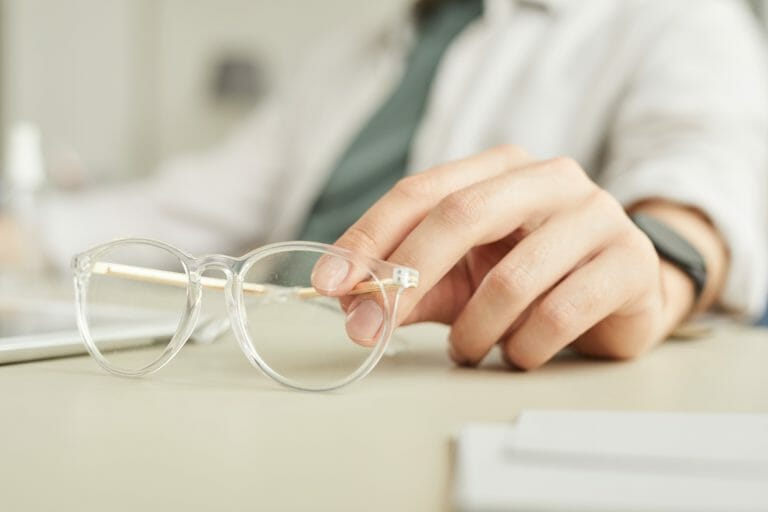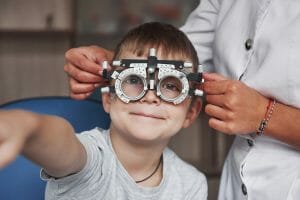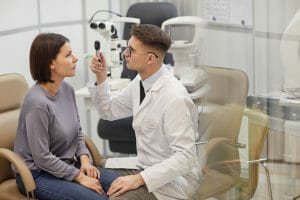Do you know that American Optometric Association reported that more than 40 percent of Americans are nearsighted? Nearsightedness in medical terms is known as myopia. It is a common vision defect in which a person cannot clearly see distant objects but can see objects close to him. Although the root cause of nearsightedness is unknown, some factors lead to this refractive error. According to various studies and research, It happens mostly due to the eye’s shape, which causes light rays to refract or bend in the wrong way, focusing images in front of the retina instead of the retina. Astigmatism is the imperfection of the cornea, which can also cause myopia. Clear vision is made when light rays come to a clever focus point on the retina. Myopia can develop rapidly or gradually, normally worsening during adolescence and childhood. It also runs in families.
To confirm you are myopic, you can go to your eye doctor for a basic eye exam. You can improve your vision and correct the refractive error with refractive surgery, glasses, or contact lenses. So you may need to wear contact lenses if you are myopic and are conscious of your eye health. Refractive surgery can also be used to correct myopia.
Symptoms of Nearsightedness (Myopia)
There is multiple myopia (nearsightedness) symptoms such as:
- Headaches due to eyestrain
- The requirement to partially close or squint the eyelids to see clearly
- Blurred vision when looking at faraway objects
- Difficulty viewing things while driving, particularly at night
Nearsightedness is usually first identified during childhood and is normally diagnosed between the early school years through the children. A child with myopia:
- Rub his/her eyes a lot
- Excessive blink
- He needs to sit at the front of his classroom, closer to the TV or movie screen.
- Seem to be unaware of distant objects
- Persistently squint
Detection On-Time of Myopia
You cannot easily pinpoint exactly what causes myopia (nearsightedness), but that doesn’t make detection well on time any less important. If myopia is identified during early childhood ages, different measures can be taken to treat myopia to slow down the progression of myopia over a kid’s lifetime.
Those children who suffer from progressive nearsightedness at an early age can tend to develop higher-level nearsightedness (known as high myopia), which is extremely severe. High myopia is a very serious eye condition. These increased levels of this visual defect can raise the chance of developing different eye conditions and problems later in life, including retinal detachment, glaucoma, degenerative myopia, macular degeneration, and many others.
Myopia is very easily diagnosed during a comprehensive, painless standard eye exam with your eye doctor. American Optometric Association recommends extensive eye exams to detect myopia. Detecting nearsightedness at an early stage in their time, then taking vital steps to decrease its progression, can immensely decrease the risk of developing eye complications later on in their life.
Many ophthalmologists prescribe contact lenses and glasses to compensate for most refractive errors. But in some cases, refractive surgery and cataract surgery is also suggested as a permanent treatment.
Causes of Nearsightedness or Myopia
Researchers who study myopia have pointed out at least two key risk factors for developing this vision condition.
Genetics
In recent years, at least 150 myopia-prone genes have been identified by scientists. One of those genes alone can’t cause the defect, but those people who care about numerous such genes have a much greater chance of developing this refractive error. Myopia-along with this genes-is passed along from a generation to the next one. When a parent or both are myopic, most likely, their child will also develop myopia.
Vision Habits
The myopia puzzle has more pieces other than just genes. Myopia can also be due to or even worsened by some vision tendencies-specifically, focusing your eyes on things up close for a more extended period. This includes consistent long hours spent reading books, looking at big screens of digital devices, or sitting in front of a computer screen.
While already present myopia normally stabilizes sometime during early adult ages, the habits children and adolescents establish before then can worsen myopia. According to the American Academy of Ophthalmology, to reduce a kid’s risk of developing nearsightedness or worsening existing refractive error, you can encourage more time outdoors and less time focused on objects close to them. Myopia may also develop in grownups because of visual stress.
Possible Complications
Myopia is linked with different complications varying from medium to extreme. These complications include:
Affect on Quality Of Life
If myopia is left untreated, it can reduce the quality of your life. You will be unable to do any activity comfortably as you want. And your incorrect vision can hinder your enjoyment of activities.
Eye Strain
If near
Impaired Safety
If you have an untreated vision problem, your safety and of other people can be jeopardized. The condition could be very serious if you are operating heavy machinery or driving a vehicle.
Financial Bu rden
rden
The price of medical treatments, corrective lenses, contact lenses, vision therapy, and eye exams can sum up. It is true, especially with nearsightedness and other chronic conditions. Vision loss and vision reduction can also affect income potential in many cases. Although you cannot compromise on your eye health and have to spend a fortune to take care of it, you should take the necessary steps to control myopia (nearsightedness).
Some Other Eye Problems
You can put yourself at a high risk of myopic maculopathy( damage in the central retinal area), retinal detachment, cataracts, degenerative myopia, and glaucoma due to severe nearsightedness. The tissues in long eyeballs are thinned and stretched, causing inflammation, tears, new blood vessels that are weak and bleed easily, and scarring.
When Should I Go To My Doctor?
If you are not able to have good and clear distance vision and cannot do tasks according to your will, or if you are unable to see distant objects and experiencing a blurry vision that creates a blockage from enjoying various activities, you should immediately visit your eye doctor. The doctor can determine the level or degree of your myopic condition and recommend to you a number of options to improve your vision.
You should consider emergency medical eye care whenever you experience:
- A shadow that looks like a curtain over your visual field
- Flashes of light in both or one eye
- If there is a sudden appearance of some floaters, specks look to move through your vision field.
These are some of the warning signs of retinal detachment, a less observed compilation of nearsightedness. It is a medical emergency, and your time is very crucial.
Eye Exams
You don’t need to have some problem with your vision, but the American Academy of Ophthalmology recommends these time intervals for frequent eye exams:
Children and Adolescents
Myopia in children can be dangerous and needs to be treated at early stages. Children should be screened for eye diseases and have their visual tests by a trained screener, a pediatrician, an optometrist, and an ophthalmologist at these intervals and ages:
- Before 1st grade and every two years during their school years, through public or school screenings or at well-child visits.
- At the age of 3
- At the age of 6 months
Adults
Get a proper eye exam every year or two, beginning at 40, when you are at a high risk of some eye disease like glaucoma.
If you are at zero to low risk of having eye diseases, don’t wear glasses or contact lenses, and don’t have any symptom of eye problem, go for an eye exam with your eye doctor at these intervals:
- After every 5 to 10 years at the age of 20s and 30s
- After every 2 to 4 years from age 40 to 54
- After every 1 to 3 years from the age of 55 to 64
- After every 1 to 2 years after the age of 65
- Every one to two years after the age of 65
Suppose you do need to wear contact lenses, corrective lenses, and glasses or suffer from a health condition that badly affects your eyes, like diabetes. In that case, it looks like you need to visit your doctor regularly to get your eyes checked. You may question your doctor about your schedule of appointments. But, if you observe any problem with your clear vision, fix a meeting with the doctor as soon as you can, even if you had an eye exam very recently. Consider blurred vision as an example. Your doctor may advise you to change your prescription, or maybe it is a sign of another eye problem. Eye surgery can fix your visual problem.







